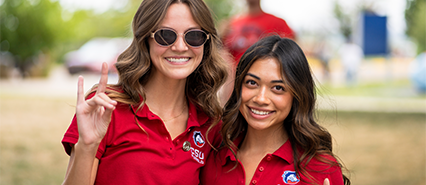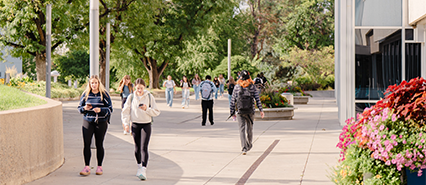Copyright
This guide is intended to provide CSU-Pueblo faculty, staff, and students with an understanding of copyright law, fair use applications, and intellectual property law.
DISCLAIMER: Nothing on these pages should be construed as legal advice. Please contact the CSU Office of General Counsel <http://www.csusystem.edu/general-counsel> for legal assistance.
COPYRIGHT POLICIES AT CSU-PUEBLO
The CSU-Pueblo Faculty Handbook <http://www.csupueblo.edu/FacultySenate/FacultyHandbook/Documents/2013/Fac-Handbook-full-version-2013.pdf> requires faculty to adhere to all applicable laws and policies regarding copyright. General policy states that faculty are the sole copyright holders of their scholarly works and pedagogical tools (articles, textbooks, lectures), but there are exceptions for works expressly commissioned by the University, produced using University resources, or works financed by outside agencies. See section 2.6.1 for more information.
The CSU-Pueblo Administrative/Professional Staff Handbook <http://www.csupueblo.edu/HR/Handbooks/Documents/AdminProHandbook.pdf> states “employees should be aware of the rules governing the use of copyright materials” (3.3).
The CSU-Pueblo Student Code of Conduct <http://www.csupueblo.edu/StudentLife/StudentConduct/StudentConductCode/Documents/The-Student-Code-of-Conduct.pdf> prohibits CSU-Pueblo students from using University technology resources to violate copyright law (12.c).
COPYRIGHT BASICS
What is copyright?
Copyright is a form of protection grounded in the Constitution (Article 1, Section 8), and granted by law (17 U.S.C. § 107 <http://www.copyright.gov/title17/92chap1.html#107>) that covers both published and unpublished original works of authorship fixed in a tangible medium of expression.
What does copyright protect?
Copyright protects original works of authorship fixed in a tangible form of expression. There are eight general categories of such works, which should be interpreted broadly:
• literary works
• musical works, including any accompanying words
• dramatic works, including any accompanying music
• pantomimes and choreographic works
• pictorial, graphic, and sculptural works
• motion pictures and other audiovisual works
• sound recordings
• architectural works
What does copyright NOT protect?
Copyright does not protect facts, ideas, systems, or methods of operation, although it may protect the way these things are expressed. It also does not protect data (although it may protect the ways data is expressed, like graphs and charts).
I am the copyright holder. What am I allowed to do?
As the copyright holder, you have the exclusive right to do and authorize others to do the following:
• Make copies of the work
• Make derivative works based on the original work
• Distribute copies of the work by sale, rental, lease, or lending
• Perform or display the work publicly (in the case of literary, musical, dramatic, choreographic, artistic, sculptural or audiovisual works)
These rights can be transferred in whole or in part to other entities through a written and signed contract.
Who can claim copyright?
As soon as a work is created in a fixed medium (e.g., written down, graphed, coded), the work is copyrighted and belongs to the creator(s). There is no need to register the work to obtain copyright. If the creator wishes to publish or distribute the work, they may sign a contract with a publishing or recording company. The company will need to acquire some or all of the copyrights in order to edit, print, copy, and sell the work.
If the creator(s) transfer full copyrights to another entity, this entity can claim copyright infringement for unlawful copies, modifications, or distributions of the work. The creator(s) are no longer able to make copies or distribute the work (even for classroom use) without permission of the copyright holder.
FAIR USE
Fair use permits the unlicensed use of copyright-protected works in certain circumstances. There is a common misconception that education and teaching automatically fall under fair use, but this is not true. 17 U.S.C. § 107 <http://www.copyright.gov/title17/92chap1.html#107> provides the statutory framework for determining whether something is a fair use and identifies certain types of uses—criticism, comment, news reporting, teaching, scholarship, and research—as examples of activities that may qualify. Classroom instructors must follow this framework, as well as additional criteria covered in the Copyright for Instructors section, in determining fair use applications.
Factors to Determine Fair Use
There are no hard and fast rules for what qualifies as fair use. Instead, there are four factors used to determine fair use (Notice that education is not listed anywhere). No one factor can decide whether a particular case qualifies; it is the combination of these four factors that you (or the court) must consider.
Purpose and character of the use
Transformative uses (adding something new, with a different purpose or character) is more likely to be considered fair use. Commercial vs. noncommercial use is considered, but not all educational and nonprofit uses are fair, nor are all commercial uses unfair.
In what ways does the original work relate to copyright's core purpose of encouraging creative expression?
Using a creative or imaginative work (such as a novel, movie, or song) is less likely to support a claim of fair use than using a factual work (such as a news item or technical article). Use of an unpublished work is also less likely to support a claim of fair use.
Amount and substantiality of the portion used in relation to the copyrighted work as a whole
Using a large portion of the original work is not likely to be considered fair use; employing only a small amount of copyrighted material is more likely to be fair. Some courts have found use of an entire work to be fair under certain circumstances; in other cases, even using a small portion of the work was determined to be unfair because it was a crucial part—or the "heart"—of the original work.
Effect of the use on the potential market for or value of the copyrighted work
If the proposed use has the potential to disrupt sales or cause substantial harm for the original material, fair use is less likely.
Fair Use Checklists
These worksheets are useful in evaluating specific fair use applications.
• Columbia University Libraries: Fair Use Checklist <https://copyright.columbia.edu/basics/fair-use/fair-use-checklist.html#Fair Use Checklist>
• Cornell University: Fair Use Checklist <http://copyright.cornell.edu/policies/docs/Fair_Use_Checklist.pdf>
• American Libraries Association: Checklist for Fair Use <http://www.ala.org/advocacy/sites/ala.org.advocacy/files/content/copyright/FairUseChecklist.pdf>
COPYRIGHT FOR INSTRUCTORS
Public Performance Rights Basics
Public Performance Rights are the legal rights to publicly show a film or video (17 U.S.C. § 110 <https://www.copyright.gov/title17/92chap1.html#110>). Normally the media producer or distributor manages these rights. Public Performance Rights are not required for home viewing or screening media in a face-to-face classroom as part of the regular curriculum. However, to screen media to audiences outside of a classroom, such as at a student club event, an on-campus lecture open to the public, or a film series, Public Performance Rights ARE required.
Furthermore, obtaining Public Performance Rights does not give the presenter the right to charge admission or profit from the screening.
Public Performance Rights at CSU-Pueblo
Showing media, whether borrowed from the library or rented/purchased, outside of the classroom may be illegal and may place the University at risk. Since the CSU-Pueblo Library purchases media to support the curriculum (and face-to-face teaching is exempt), not all of the library's DVDs and videos have Public Performance Rights. At this time, information about public performance rights is not included in the library catalog. You will need to contact the library to ask about particular items.
All movies and documentaries available on Kanopy <http://csupueblo.kanopystreaming.com/> include public performance rights, meaning they can be shown on campus as long as no admission is charged or profits are made from the screening.
Fair Use for Instructors
There is a common misconception that using a copyrighted work for education or teaching automatically qualifies as fair use. This is not the case. Instructors are permitted to make multiple copies (no more than one copy per student) for classroom use or discussion only if the copying meets the tests for brevity, spontaneity, and cumulative effect, and if each copy includes a copyright notice.
Brevity
Brevity refers to how much of the work you can copy. There are rules for poetry, prose, illustrations, and special works (works that combine words and illustrations and are less than 2,500 words total, e.g., children’s books).
[Table]
Prose Poetry Illustrations Special Works
In Whole A complete article, story or essay if it is <2,500 words total A complete poem <250 words total, or printed on less than two pages N/A N/A
In Part An excerpt between 500–1,000 words OR 10% of the entire work [and still >500 words], whichever is less An excerpt of not more than 250 words One chart, graph, diagram, drawing, cartoon or picture per book or periodical issue An excerpt not more than 10% of the total word count
Spontaneity
Spontaneity refers to how much planning it would take to seek and obtain permission from the copyright holder. It is usually used when articles, books, or videos are released and instructors are inspired to modify their lesson plans to incorporate this new material sooner than they could reasonably track down and receive permission from the copyright holder.
Copies made under spontaneity should be for one course at one school, and include a notice of copyright acknowledging the author of the work.
Cumulative Effect
Cumulative effect places additional limitations on brevity and spontaneity by capping how many times they can be applied in a single quarter or semester.
[Table]
Prose Not more than one article, story, essay, or two excerpts by a single author
Poetry Not more than one poem or two excerpts by a single author
Anthologies and Periodicals Not more than three from the same collective work or periodical volume [Does not apply to current news]
Copying Not more than nine instances total for any one course
What should be avoided?
• Making multiple copies of different works that could substitute for the purchase of books, publisher's reprints, or periodicals
• Copying and using the same work from semester to semester
• Copying and using the same material for several different courses at the same or different institutions
• Copying more than nine separate times in a single semester
When is permission required?
• When you intend to use the materials for a commercial purpose (this includes creating and selling coursepacks)
• When you want to use the materials repeatedly, or for different classes
• When you want to use a work in its entirety, especially if it is longer than 2,500 words
How do I get permission? What can the library do?
The CSU-Pueblo Library can place copies of copyrighted articles, readings, and short audio or video clips on Reserve or eReserve for your class, and provide a password-protected link to post in Blackboard.
Distance/Online Learning
The Classroom Use Exemption (17 U.S.C. § 110(1) <https://www.law.cornell.edu/uscode/text/17/110>) only applies to in-person, face-to-face instruction in a classroom at a non-profit educational institution. It allows for the performance or display of any copyrighted work without seeking permission, but does not apply to making or distributing copies or to online instruction.
The TEACH Act (S. 487 <https://copyright.gov/docs/regstat031301.html>) allows instructors to perform or display copyrighted works in distance education environments under a number of restrictions. The requirements are outlined below.
[Accordion]
Qualifications
• Accredited non-profit educational institution
• Material is part of systematic mediated instructional activities
Notifications and Education
• Institutional copyright use policy
• Copyright education for instructors and students
Lawfulness
• Digital material has not been produced by a digital education publisher
• All digital material is lawfully made and acquired
Access Control
• Limited to students enrolled in the course
• Reasonable copy control instituted
Relevance
• Digital material is essential and integral to the course
• Material is directly related to teaching lessons or other objectives
Specific Usage
• Copyright notice present on all materials used in course
• “reasonable and limited” portions of material used
Further reading and additional resources
• ASU Online's Implementation of the TEACH Act <http://onlinestudio.asu.edu/teach-act/resources-for-instructors>
• TEACH Act Toolkit - from the University of North Carolina - Charlotte Library <http://library.uncc.edu/copyright/TEACH>
Using Copyrighted Works in Blackboard
There is an important difference between uploading and linking to assigned readings in Blackboard. Instructors should avoid uploading files and instead contact the library to place books and articles on Reserve or eReserve. The library will provide a password-protected link to post in Blackboard. This complies with licensing agreements and avoids copyright infringement.


